The online newspaper Metro has put record traffic figures down to its successful use of social media websites. Having undergone a major redesign in December 2012, the site has gone on to reach new heights; something that owners Associated Press have said is down to the introduction of the mobile friendly design and also the use of streams and a strong social media influence. A 21% month on month increase means that the so-called freesheet attracted more than 20 million visitors in November this year.
Metro offers news content, and this is considered one of the most popular forms of mobile media. People enjoy consuming news on mobile devices because of the convenience and because they can access the latest headlines and the latest stories no matter where they are or what they are doing. In order to benefit from this, Metro took the brave move to completely revamp their site.
Back in October, Metro released figures that showed traffic was up 177% for the year from January to October. Mobile traffic had increased an impressive 225% while referrals from social media were up five-fold. The media company attributed this social referral increase to an improved user experience but also to the publishing of social media friendly content; content that can easily be shared via social networks and social media platforms.
There are a number of ways that a business can offer a mobile friendly experience, but one of the most effective is to use a responsive web design. A responsive website will display normally on a desktop or laptop computer, and the dimensions of the site will change for those that access the website on devices with smaller screens. This means that whether a person visits a site using their desktop or their smartphone, they will be presented with the content that the website offers.
News related content, like the content published by metro.co.uk is extremely popular with social media users. People are more inclined to share newsworthy content than promotional content and this means that the latest news stories can be shared regularly and frequently. In order to encourage greater social media sharing, websites will often introduce the use of social media sharing buttons. However, it is the quality and style of the content that will also play a big part.
As well as adding share buttons, publishers need to bear in mind that news content will be viewed on mobile devices. Everything should be optimised for mobile, while the content itself should be written to such a standard that people will want to share it with their colleagues, friends, and family. A headline that grabs attention, content that keeps attention, and additional media to support the story will all prove to be efficient at encouraging social media shares.
There were other factors that undoubtedly helped to encourage greater use for metro.co.uk. Some previously popular sites like the Sun’s online offering introduced a paywall rather than offering content for free. Sites with a paywall will usually offer minimal content for free, before charging a subscription fee for anybody that wants to read more or wants to continue reading the stories that the site publishes. As people turned away from sites that started using this model, they will have looked for alternatives.
Optimising a site for mobile and social media can pay great dividends in generating traffic, especially if the site has a strong social and mobile following already. Metro took the decision to redesign because news based media is popular with mobile users, and a massive increase in traffic as well as record breaking readership figures vindicate the decision that they made.
What do you think to our blog? Why not share some links to your social media blogs so other can see what works well for you.

